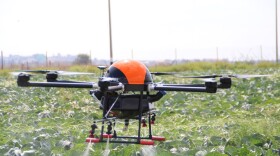A new study from the University of Michigan says animal feeding operations are often in poorer neighborhoods that have worse air quality. The study used open-source data and satellite imagery to locate 15,726 cattle and hog feeding operations across America.
Researchers say it's the most detailed survey of animal feeding operations to date.
“Access to comprehensive data on cattle AFOs and hog farms location remains siloed at the individual state level, is often kept confidential by state agencies, or is incomplete,” the study says.
Data shows these operations, in which animals are fed and kept for over 45 days, tend to be in areas where there's higher levels of air pollution. The study focused on the pollutant PM2.5.
PM2.5 levels on average, were “28% higher near cattle feeding operations and 11% higher near hog operations compared with similar counties without AFOs,” the study reads.
Sanaz Chamanara was one of the researchers. She says PM2.5 is linked to numerous health issues.
"There is no safe level of PM2.5, and PM2.5 actually is linked to asthma, cancer like leukemia, cardiovascular diseases,” she said.
The thumb and southwest Michigan have the highest concentration of animal feeding operations in the state. While the state doesn’t rank among the highest in terms of AFO’s, Chamanara said there were still useful conclusions.
“Michigan has a lot of these local pockets and people living near these large facilities,” she said. “I think a little targeted monitoring could go a long way.”
Data also found communities with animal feeding operations are more likely to have lower levels of health insurance and education. Those counties also generally had higher percentages of Latino residents.
Across the country, California led the way with 1,385 cattle operations. Wisconsin, Nebraska, Idaho and Iowa rounded out the top five respectively, all of them had over 600 AFOs.
Iowa also had the most hog farms with 2,119. Minnesota, North Carolina, Oklahoma and Missouri were withing the top five.
Researchers hope the data can inform lawmakers and identify vulnerable communities in need of “pollution reduction measures.”
Tess Van Gorder with the Michigan Farm Bureau said in a statement that “livestock farmers of all sizes work to be good stewards of the environment and the communities that they and their families live and work in," Van Gorder said.
“The authors of the study are correct to point out that correlation doesn’t always indicate causation, and it’s worth noting that the air quality results are reported at an aggregated level — not by state or county,” she continued.
Van Gorder said farmers abide by stringent state permitting and work together to raise food safely and sustainably.



